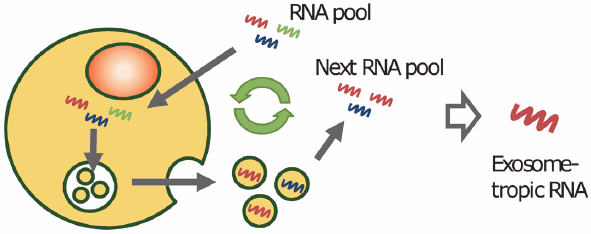2 0 0 0 OA SELEX-Based Screening of Exosome-Tropic RNA
- 著者
- Takuma Yamashita Haruka Shinotsuka Yuki Takahashi Kana Kato Makiya Nishikawa Yoshinobu Takakura
- 出版者
- The Pharmaceutical Society of Japan
- 雑誌
- Biological and Pharmaceutical Bulletin (ISSN:09186158)
- 巻号頁・発行日
- vol.40, no.12, pp.2140-2145, 2017-12-01 (Released:2017-12-01)
- 参考文献数
- 23
- 被引用文献数
- 9
Cell-derived nanosized vesicles or exosomes are expected to become delivery carriers for functional RNAs, such as small interfering RNA (siRNA). A method to efficiently load functional RNAs into exosomes is required for the development of exosome-based delivery carriers of functional RNAs. However, there is no method to find exosome-tropic exogenous RNA sequences. In this study, we used a systematic evolution of ligands by exponential enrichment (SELEX) method to screen exosome-tropic RNAs that can be used to load functional RNAs into exosomes by conjugation. Pooled single stranded 80-base RNAs, each of which contains a randomized 40-base sequence, were transfected into B16-BL6 murine melanoma cells and exosomes were collected from the cells. RNAs extracted from the exosomes were subjected to next round of SELEX. Cloning and sequencing of RNAs in SELEX-screened RNA pools showed that 29 of 56 clones had a typical RNA sequence. The sequence found by SELEX was enriched in exosomes after transfection to B16-BL6 cells. The results show that the SELEX-based method can be used for screening of exosome-tropic RNAs.
- 著者
- Shin SHIMADA Takahiro YOSHIZAWA Yuki TAKAHASHI Yuko NITAHARA-KASAHARA Takashi OKADA Yoshihiro NOMURA Hitoki YAMANAKA Tomoki KOSHO Kiyoshi MATSUMOTO
- 出版者
- Japanese Association for Laboratory Animal Science
- 雑誌
- Experimental Animals (ISSN:13411357)
- 巻号頁・発行日
- vol.69, no.4, pp.407-413, 2020 (Released:2020-11-12)
- 参考文献数
- 19
- 被引用文献数
- 2 3
Ehlers–Danlos syndromes (EDSs) are heterogeneous group of heritable connective tissue disorders characterized by joint and skin hyperextensibility as well as fragility of various organs. Recently, we described a new type of EDS, musculocontractual EDS (mcEDS-CHST14), caused by pathogenic variants of the carbohydrate sulfotransferase 14 (CHST14) gene mutation. B6;129S5-Chst14tm1Lex/Mmucd (B6;129-Chst14 KO) mice are expected to be an animal model of mcEDS-CHST14. However, >90% of B6;129-Chst14 KO homozygous (B6;129-Chst14−/−) mice show perinatal lethality. Therefore, improvement of the birth rate of Chst14−/− mice is needed to clarify the pathophysiology of mcEDS-CHST14 using this animal model. Some B6;129-Chst14−/− embryos had survived at embryonic day 18.5 in utero, suggesting that problems with delivery and/or childcare may cause perinatal lethality. However, in vitro fertilization and egg transfer did not improve the birth rate of the mice. A recent report showed that backcrossing to C57BL/6 strain induces perinatal death of all Chst14−/− mice, suggesting that genetic background influences the birthrate of these mice. In the present study, we performed backcrossing of B6;129-Chst14 KO mice to a BALB/c strain, an inbred strain that shows lower risks of litter loss than C57BL/6 strain. Upon backcrossing 1 to 12 times, the birth rate of Chst14−/− mice was improved with a birth rate of 6.12–18.64%. These results suggest that the genetic background influences the birth rate of Chst14−/− mice. BALB/c congenic Chst14−/− (BALB.Chst14−/−) mice may facilitate investigation of mcEDS-CHST14. Furthermore, backcrossing to an appropriate strain may contribute to optimizing animal experiments.
1 0 0 0 IR 橘則光について--『枕草子』を中心に
- 著者
- 高橋 由記 Yuki TAKAHASHI 明星大学日本文化学部言語文化学科
- 出版者
- 明星大学青梅校
- 雑誌
- 明星大学研究紀要 日本文化学部・言語文化学科 (ISSN:13444387)
- 巻号頁・発行日
- no.15, pp.131-142, 2007
